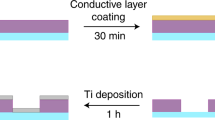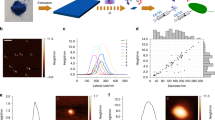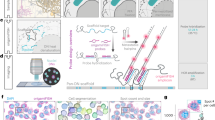Abstract
To address the need for a bright, photostable labeling tool that allows long-term in vivo imaging in whole organisms, we recently introduced second harmonic generating (SHG) nanoprobes. Here we present a protocol for the preparation and use of a particular SHG nanoprobe label, barium titanate (BT), for in vivo imaging in living zebrafish embryos. Chemical treatment of the BT nanoparticles results in surface coating with amine-terminal groups, which act as a platform for a variety of chemical modifications for biological applications. Here we describe cross-linking of BT to a biotin-linked moiety using click chemistry methods and coating of BT with nonreactive poly(ethylene glycol) (PEG). We also provide details for injecting PEG-coated SHG nanoprobes into zygote-stage zebrafish embryos, and in vivo imaging of SHG nanoprobes during gastrulation and segmentation. Implementing the PROCEDURE requires a basic understanding of laser-scanning microscopy, experience with handling zebrafish embryos and chemistry laboratory experience. Functionalization of the SHG nanoprobes takes ∼3 d, whereas zebrafish preparation, injection and imaging setup should take approximately 2–4 h.
This is a preview of subscription content, access via your institution
Access options
Subscribe to this journal
Receive 12 print issues and online access
$259.00 per year
only $21.58 per issue
Buy this article
- Purchase on Springer Link
- Instant access to full article PDF
Prices may be subject to local taxes which are calculated during checkout






Similar content being viewed by others
References
Olivier, N. et al. Cell lineage reconstruction of early zebrafish embryos using label-free nonlinear microscopy. Science 329, 967–971 (2010).
Brown, E. et al. Dynamic imaging of collagen and its modulation in tumors in vivo using second-harmonic generation. Nat. Med. 9, 796–800 (2003).
Franken, P.A., Hill, A.E., Peters, C.W. & Weinreich, G. Generation of optical harmonics. Phys. Rev. Lett. 7, 118–119 (1961).
Sutherland, R.L., McLean, D.G. & Kirkpatrick, S. Handbook of Nonlinear Optics (Dekker) 2nd edn. (Dekker, 2003).
Dombeck, D.A., Sacconi, L., Blanchard-Desce, M. & Webb, W.W. Optical recording of fast neuronal membrane potential transients in acute mammalian brain slices by second-harmonic generation microscopy. J. Neurophysiol. 94, 3628–3636 (2005).
Jiang, J., Eisenthal, K.B. & Yuste, R. Second harmonic generation in neurons: electro-optic mechanism of membrane potential sensitivity. Biophys. J. 93, L26–L28 (2007).
Millard, A.C. et al. Sensitivity of second harmonic generation from styryl dyes to transmembrane potential. Biophys. J. 86, 1169–1176 (2004).
Nuriya, M., Jiang, J., Nemet, B., Eisenthal, K.B. & Yuste, R. Imaging membrane potential in dendritic spines. Proc. Natl. Acad. Sci. USA 103, 786–790 (2006).
Reeve, J.E. et al. Amphiphilic porphyrins for second harmonic generation imaging. J. Am. Chem. Soc. 131, 2758–2759 (2009).
Sacconi, L., Dombeck, D.A. & Webb, W.W. Overcoming photodamage in second-harmonic generation microscopy: real-time optical recording of neuronal action potentials. Proc. Natl. Acad. Sci. USA 103, 3124–3129 (2006).
Brown, R.M. Jr, Millard, A.C. & Campagnola, P.J. Macromolecular structure of cellulose studied by second-harmonic generation imaging microscopy. Opt. Lett. 28, 2207–2209 (2003).
Campagnola, P.J. & Loew, L.M. Second-harmonic imaging microscopy for visualizing biomolecular arrays in cells, tissues and organisms. Nat. Biotechnol. 21, 1356–1360 (2003).
Campagnola, P.J. et al. Three-dimensional high-resolution second-harmonic generation imaging of endogenous structural proteins in biological tissues. Biophys. J. 82, 493–508 (2002).
Freund, I., Deutsch, M. & Sprecher, A. Connective tissue polarity. Optical second-harmonic microscopy, crossed-beam summation, and small-angle scattering in rat-tail tendon. Biophys. J. 50, 693–712 (1986).
Nucciotti, V. et al. Probing myosin structural conformation in vivo by second-harmonic generation microscopy. Proc. Natl. Acad. Sci. USA 107, 7763–7768 (2010).
Miller, R.C., Kleinman, D.A. & Savage, A. Quantitative studies of optical harmonic generation in CdS, BaTiO3, and KH2PO4 type crystals. Phys. Rev. Lett. 11, 146–149 (1963).
Pantazis, P., Maloney, J., Wu, D. & Fraser, S.E. Second harmonic generating (SHG) nanoprobes for in vivo imaging. Proc. Natl. Acad. Sci. USA 107, 14535–14540 (2010).
Dempsey, W.P., Fraser, S.E. & Pantazis, P. SHG nanoprobes: advancing harmonic imaging in biology. Bioessays 34, 351–360 (2012).
Hermanson, G.T. Bioconjugate Techniques 2nd edn. (Academic Press, 2008).
Walling, M.A., Novak, J.A. & Shepard, J.R. Quantum dots for live cell and in vivo imaging. Int. J. Mol. Sci. 10, 441–491 (2009).
Staedler, D. et al. Harmonic nanocrystals for biolabeling: a survey of optical properties and biocompatibility. ACS Nano 6, 2542–2549 (2012).
Schroeder, T. Long-term single-cell imaging of mammalian stem cells. Nat. Methods 8, S30–S35 (2011).
Cohen, B.E. Biological imaging: beyond fluorescence. Nature 467, 407–408 (2010).
Buckingham, M.E. & Meilhac, S.M. Tracing cells for tracking cell lineage and clonal behavior. Dev. Cell 21, 394–409 (2011).
Grange, R., Lanvin, T., Hsieh, C.L., Pu, Y. & Psaltis, D. Imaging with second-harmonic radiation probes in living tissue. Biomed. Opt. Express 2, 2532–2539 (2011).
Jaiswal, J.K., Goldman, E.R., Mattoussi, H. & Simon, S.M. Use of quantum dots for live cell imaging. Nat. Methods 1, 73–78 (2004).
Hsieh, C.L., Grange, R., Pu, Y. & Psaltis, D. Bioconjugation of barium titanate nanocrystals with immunoglobulin G antibody for second harmonic radiation imaging probes. Biomaterials 31, 2272–2277 (2010).
Ould-Ely, T. et al. Large-scale engineered synthesis of BaTiO nanoparticles using low-temperature bioinspired principles. Nat. Protoc. 6, 97–104 (2011).
Chang, S.J., Liao, W.S., Ciou, C.J., Lee, J.T. & Li, C.C. An efficient approach to derive hydroxyl groups on the surface of barium titanate nanoparticles to improve its chemical modification ability. J. Colloid Interface Sci. 329, 300–305 (2009).
Kolen'ko, Y.V. et al. A novel, controlled, and high-yield solvothermal drying route to nanosized barium titanate powders. J. Phys. Chem. B 111, 7306–7318 (2007).
Arkles, B., Pan, Y., Larson, G.L. & Berry, D.H. Cyclic azasilanes: volatile coupling agents for nanotechnology. Silanes and Other Coupling Agents 3, 179–191 (2004).
Agard, N.J., Prescher, J.A. & Bertozzi, C.R. A strain-promoted [3 + 2] azide-alkyne cycloaddition for covalent modification of biomolecules in living systems. J. Am. Chem. Soc. 126, 15046–15047 (2004).
Karakoti, A.S., Das, S., Thevuthasan, S. & Seal, S. PEGylated inorganic nanoparticles. Angew. Chem. Int. Ed. Engl. 50, 1980–1994 (2011).
Przybyszewska, M., Krzywania, A., Zaborski, M. & Szynkowska, M.I. Surface properties of zinc oxide nanoparticles studied by inverse gas chromatography. J. Chromatogr. A 1216, 5284–5291 (2009).
Asakuma, N., Fukui, T., Toki, M., Awazu, K. & Imai, H. Photoinduced hydroxylation at ZnO surface. Thin Solid Films 445, 284–287 (2003).
Kim, P. et al. Phosphonic acid-modified barium titanate polymer nanocomposites with high permittivity and dielectric strength. Adv. Mater. 19, 1001–1005 (2007).
Bagwell, R., Sindel, J. & Sigmund, W. Morphological evolution of barium titanate synthesised in water in the presence of polymeric species. J. Mater. Res. 14, 1844–1851 (1999).
Li, G.L., Wan, D., Neoh, K.G. & Kang, E.T. Binary polymer brushes on silica@polymer hybrid nanospheres and hollow polymer nanospheres by combined alkyne-azide and thiol-ene surface click reactions. Macromolecules 43, 10275–10282 (2010).
Harper, C. & Lawrence, C. The Laboratory Zebrafish (CRC Press, 2010).
Kilkenny, C., Browne, W.J., Cuthill, I.C., Emerson, M. & Altman, D.G. Improving bioscience research reporting: the ARRIVE guidelines for reporting animal research. PLoS Biol. 8, e1000412 (2010).
Kimmel, C.B., Ballard, W.W., Kimmel, S.R., Ullmann, B. & Schilling, T.F. Stages of embryonic development of the zebrafish. Dev. Dyn. 203, 253–310 (1995).
Westerfield, M. The Zebrafish Book. A Guide for the Laboratory Use of Zebrafish (Danio rerio) (University of Oregon Press, 2000).
Mohrig, J.R., Hammond, C.N. & Schatz, P.F. Techniques in Organic Chemistry 2nd edn. (W.H. Freeman and Company, 2006).
Caneparo, L., Pantazis, P., Dempsey, W. & Fraser, S.E. Intercellular bridges in vertebrate gastrulation. PLoS ONE 6, e20230 (2011).
Higashijima, S., Okamoto, H., Ueno, N., Hotta, Y. & Eguchi, G. High-frequency generation of transgenic zebrafish which reliably express GFP in whole muscles or the whole body by using promoters of zebrafish origin. Dev. Biol. 192, 289–299 (1997).
Kawakami, K. & Shima, A. Identification of the Tol2 transposase of the medaka fish Oryzias latipes that catalyzes excision of a nonautonomous Tol2 element in zebrafish Danio rerio. Gene 240, 239–244 (1999).
White, R.M. et al. Transparent adult zebrafish as a tool for in vivo transplantation analysis. Cell Stem Cell 2, 183–189 (2008).
Mazdiyasni, K.S., Dolloff, R.T. & Smith, J.S. Preparation of high-purity submicron barium titanate powders. J. Am. Ceram. Soc. 52, 523–526 (1969).
Last, J.T. Infrared-absorption studies on barium titanate and related materials. Phys. Rev. 105, 1740–1750 (1957).
Launer, P.J. Infrared analysis of organosilicon compounds: spectra-structure correlations. Silicone Compounds Register and Review (Reprint) 100–103 (1987).
Hopt, A. & Neher, E. Highly nonlinear photodamage in two-photon fluorescence microscopy. Biophys. J. 80, 2029–2036 (2001).
Acknowledgements
We thank J. Szychowski and F. Troung (California Institute of Technology) for the gift of 6-azido-hexanoic acid and biotin-PEO-cyclooctyne. J.C.-V. thank J. Szychowski for fruitful discussions on the click chemistry functionalization and C. Garland for her assistance with the TEM imaging. We also thank A. Collazo for access to the Confocal Microscopy Core at the House Research Institute. This work was supported by grants obtained by S.E.F. from the Caltech Beckman Institute and from funds obtained by P.P. from the California Institute for Regenerative Medicine Bridges Internship Program and from the Swiss National Center of Competence in Research 'Nanoscale Science'.
Author information
Authors and Affiliations
Contributions
J.C.-V., W.P.D., S.E.F. and P.P. designed the protocol, designed the imaging experiments and conceived the chemistry for the functionalization steps. J.C.-V. performed chemical analyses for the functionalization of BT. W.P.D. performed the imaging of the SHG nanoprobes and analyzed the resulting data. J.C.-V., W.P.D., S.E.F. and P.P. drafted the manuscript.
Corresponding author
Ethics declarations
Competing interests
This work is the subject of patent applications filed by the California Institute of Technology.
Supplementary information
Supplementary Video 1
Rotation of the surface projection image from Fig. 5a. This video illustrates the extent of PEG-BT labeling within a sphere stage zebrafish embryo after successful zygote stage injection. 10,000 MW Dextran-AlexaFluor546 labels the cell interior of each of the blastomeres within the embryo (red), while the yolk cell appears dark. SHG nanoprobes (white) can be seen even as deep as ∼70 µm (in the z direction) within the cells of the blastodisc during the rotation. Linear contrast adjustments were applied to each of the images as well as median filtering (0 to 1 pixel) using Adobe Photoshop CS3 (Adobe Systems) or ImageJ (NIH). Scale bar: 100 µm. (MOV 2073 kb)
Supplementary Video 2
Visualization of PEG-BT within Bodipy TR methyl-ester labeled blastomeres during the sphere stage of development. See Fig. 5b for one of the optical slices. This video is a progression through 40 optical slices (2 µm between each in the z-direction, ∼76 µm total depth) of an animal pole mounted zebrafish embryo co-labeled with Bodipy TR methyl-ester (red) to visualize cell cytoplasmic contents (nuclei appear dark). PEG-BT clusters (white) of varying size can be seen with high contrast throughout the depth and remain within the cells of the embryo. Linear contrast adjustments were applied to each of the images as well as median filtering (0 to 1 pixel) using Adobe Photoshop CS3 (Adobe Systems) or ImageJ (NIH). Scale bar: 100 µm. (MOV 1121 kb)
Supplementary Video 3
Imaging PEG-BT within a live, early segmentation period embryo. See Fig. 5c for one of the optical slices. This video is a progression through 12 optical slices (2 µm between each in the z-direction, ∼20 µm total depth) of a dorsally mounted (anterior top) zebrafish embryo at the 5 somite stage co-labeled with Bodipy FL C5 ceramide (green) to visualize cell boundaries (cell contents appear dark). PEG-BT clusters (white) of varying size are seen within the boundaries of cells in the somites, the notochord (center midline extending from top to bottom), and neural territories. Since the embryo is <16 hr post fertilization, it does not need to be anesthetized during imaging and pigment has yet to be produced, so Tricaine methanesulfonate and PTU treatment are unnecessary. Linear contrast adjustments were applied to each of the images as well as median filtering (0 to 1 pixel) using Adobe Photoshop CS3 (Adobe Systems) or ImageJ (NIH). Note that nonlinear contrast adjustments were performed on the bright field image to give better contrast to the tissue. Scale bar: 50 µm. (MOV 1437 kb)
Supplementary Video 4
in vivo time-lapse video of PEG-BT as seen in static time-points in Fig. 6. This video depicts a maximum intensity projection of cells within ∼7.5 µm in depth labeled with PEG-BT (white) and mosaically-expressed, membrane-targeted Dendra2 (green). The first frame shows the three PEG-BT nanoprobes that were labeled in Fig. 6 that can be followed in time by eye, because of the high contrast of the SHG signal. Note that two SHG nanoprobes – labeled in the initial time-point with white and orange arrows – move beneath the plane of focus during the time-lapse. Interestingly, several PEG-BT nanoprobes seem to mark cells that are not labeled with Dendra2, because they seem to move at approximately the same rate as other cells in the image while not being inside any of the labeled cells themselves. Note that the varying sizes of the nanoprobes within the video presumably stem from anomalous subdiffusion and molecular crowding within cell compartments (e.g. endocytic compartments). Linear contrast adjustments were applied to each of the images as well as median filtering (0 to 1 pixel) using Adobe Photoshop CS3 (Adobe Systems) or ImageJ (NIH). Time-stamps: min:sec. Scale bar: 20 µm. (MOV 4977 kb)
Rights and permissions
About this article
Cite this article
Čulić-Viskota, J., Dempsey, W., Fraser, S. et al. Surface functionalization of barium titanate SHG nanoprobes for in vivo imaging in zebrafish. Nat Protoc 7, 1618–1633 (2012). https://doi.org/10.1038/nprot.2012.087
Published:
Issue Date:
DOI: https://doi.org/10.1038/nprot.2012.087
This article is cited by
-
BaTiO3@Au nanoheterostructure suppresses triple-negative breast cancer by persistently disrupting mitochondrial energy metabolism
Nano Research (2023)
-
Confocal imaging of single BaTiO3 nanoparticles by two-photon photothermal microscopy
Scientific Reports (2017)
-
Labeling cellular structures in vivo using confined primed conversion of photoconvertible fluorescent proteins
Nature Protocols (2016)
-
Cyclodextrin-grafted barium titanate nanoparticles for improved dispersion and stabilization in water-based systems
Journal of Nanoparticle Research (2016)
-
Determination of the source of SHG verniers in zebrafish skeletal muscle
Scientific Reports (2015)
Comments
By submitting a comment you agree to abide by our Terms and Community Guidelines. If you find something abusive or that does not comply with our terms or guidelines please flag it as inappropriate.



